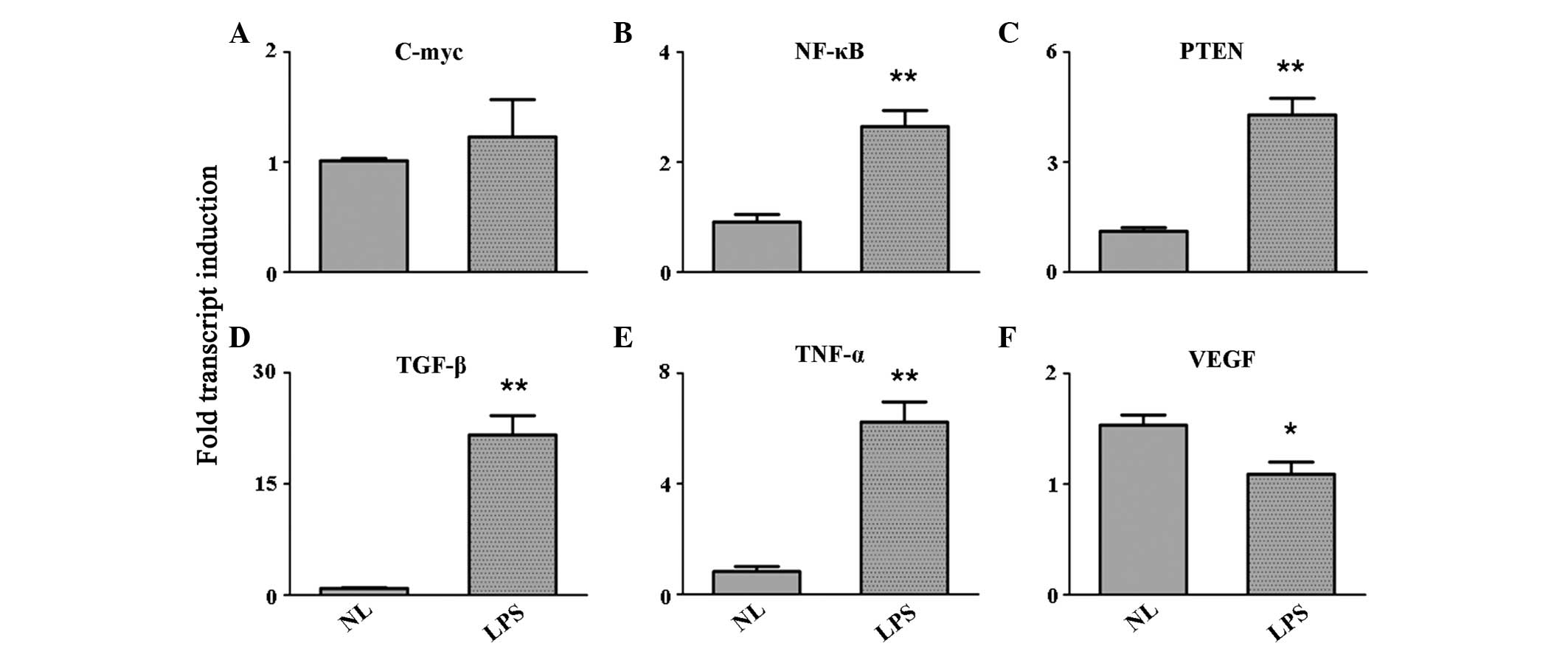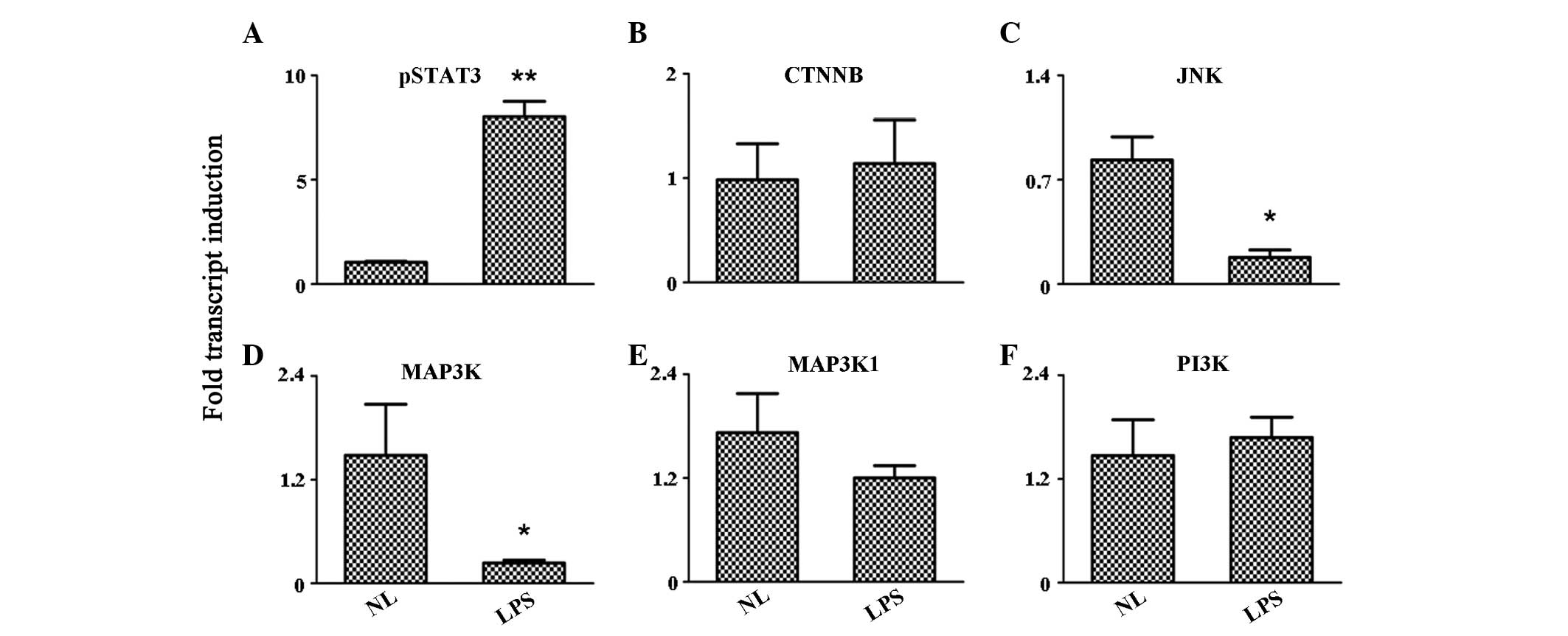Toll‑like receptor 4 agonist, lipopolysaccharide, increases the expression levels of cytokines and chemokines in human peripheral blood mononuclear cells
- Authors:
-
View Affiliations
Affiliations: Clinical Skills Training Center, West China Hospital, Sichuan University, Chengdu, Sichuan 610041, P.R. China, Department of Pathology, West China Second University Hospital, Sichuan University, Chengdu, Sichuan 610041, P.R. China
- Published online on: October 15, 2014 https://doi.org/10.3892/etm.2014.2025
-
Pages:
1914-1918
Metrics:
Total
Views: 0 (Spandidos Publications: | PMC Statistics:
)
Metrics:
Total PDF Downloads: 0 (Spandidos Publications: | PMC Statistics:
)
This article is mentioned in:
Abstract
Toll‑like receptors (TLRs) are members of the pattern recognition receptor family and are essential in the innate immune response. In total, 11 TLRs exist in humans, which are expressed in a variety of cells, including peripheral blood cells. TLR4 plays a significant role in the defense against gram‑negative pathogens by recognizing the lipopolysaccharide (LPS) molecules in these bacteria. The aim of the present study was to detect the expression level variation of a number of major immune molecules in peripheral blood mononuclear cells (PBMCs) stimulated by LPS, in order to identify candidate genes involved in the biological functions mediated by TLR4. Reverse transcription quantitative polymerase chain reaction (RT‑qPCR) analysis and an antibody chip were performed in the current study. The RT‑qPCR results revealed a marked enhancement in the expression levels of various molecules, including cytokines, chemokines, growth factors and protein kinases. In addition, the antibody chip identified the increased secretion of crucial proinflammatory molecules in the supernatants collected from LPS‑treated PBMCs. In conclusion, a large number of molecules were found to be involved in TLR4‑mediated functions.
View References
|
1
|
Takeuchi O and Akira S: Pattern
recognition receptors and inflammation. Cell. 140:805–820. 2010.
View Article : Google Scholar : PubMed/NCBI
|
|
2
|
Hou B, Reizis B and DeFranco AL: Toll-like
receptors activate innate and adaptive immunity by using dendritic
cell-intrinsic and -extrinsic mechanisms. Immunity. 29:272–282.
2008. View Article : Google Scholar : PubMed/NCBI
|
|
3
|
Miyake K: Innate immune sensing of
pathogens and danger signals by cell surface Toll-like receptors.
Semin Immunol. 19:3–10. 2007. View Article : Google Scholar : PubMed/NCBI
|
|
4
|
Blasius AL and Beutler B: Intracellular
Toll-like receptors. Immunity. 32:305–315. 2010. View Article : Google Scholar
|
|
5
|
Yamamato M, Sato S, Mori K, Hoshino K,
Takeuchi O, Takeda K and Akira S: Cutting edge: a novel Toll/IL-1
receptor domain-containing adapter that preferentially activates
the IFN-beta promoter in the Toll-like receptor signaling. J
Immunol. 169:6668–6672. 2002. View Article : Google Scholar : PubMed/NCBI
|
|
6
|
Ghosh TK, Mickelson DJ, Solberg JC, Lipson
KE, Inglefield JR and Alkan SS: TLR-TLR cross talk in human PBMC
resulting in synergistic and antagonistic regulation of type-1 and
2 interferons, IL-12 and TNF-alpha. Int Immunopharmacol.
7:1111–1121. 2007. View Article : Google Scholar : PubMed/NCBI
|
|
7
|
Kaisho T, Takeuchi O, Kawai T, Hoshino K
and Akira S: Endotoxin-induced maturation of MyD88-deficient
dendritic cells. J Immunol. 166:5688–5694. 2001. View Article : Google Scholar : PubMed/NCBI
|
|
8
|
Activation of the TLR1/2 pathway induces
the shaping of the immune response status of peripheral blood
leukocytes. Exp Ther Med. 7:1708–1712. 2014.PubMed/NCBI
|
|
9
|
Beutler B: Inferences, questions and
possibilities in Toll-like receptor signalling. Nature.
430:257–263. 2004. View Article : Google Scholar : PubMed/NCBI
|
|
10
|
Kopp E and Medzhitov R: Recognition of
microbial infection by Toll-like receptors. Curr Opin Immunol.
15:396–401. 2003. View Article : Google Scholar : PubMed/NCBI
|
|
11
|
Shan JY, Ji WZ, Li HT, Tuxun T, Lin RY and
Wen H: TLR2 and TLR4 expression in peripheral blood mononuclear
cells of patients with chronic cystic echinococcosis and its
relationship with IL-10. Parasite Immunol. 33:692–696. 2011.
View Article : Google Scholar : PubMed/NCBI
|
|
12
|
Kaisho T and Akira S: Toll-like receptor
function and signaling. J Allergy Clin Immunol. 117:979–987. 2006.
View Article : Google Scholar : PubMed/NCBI
|













